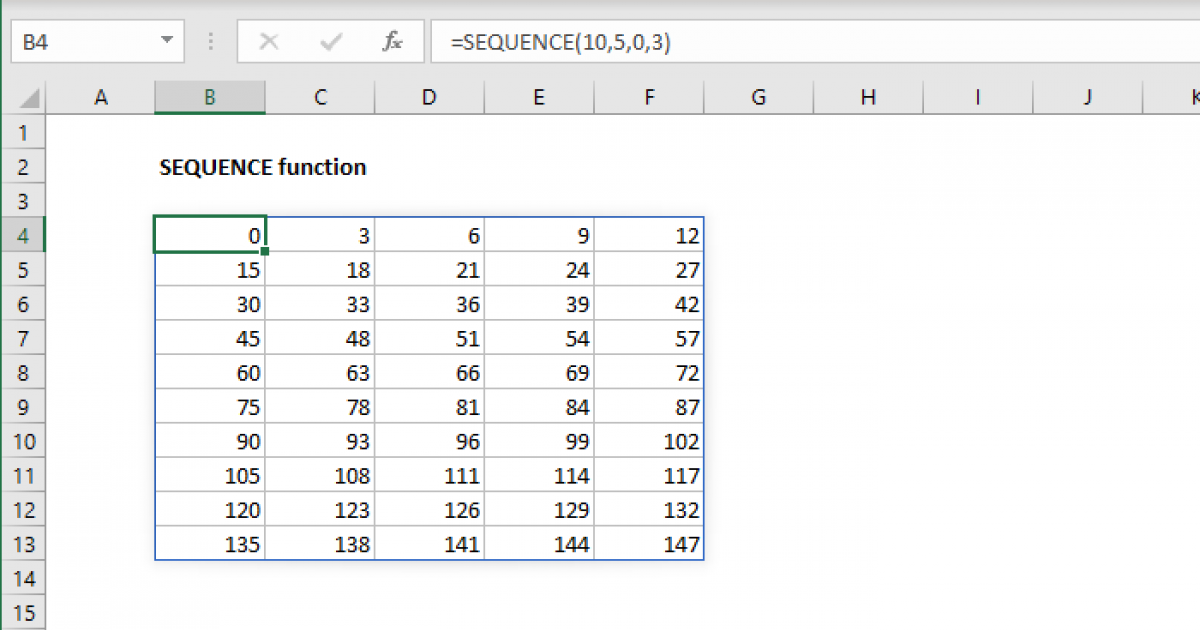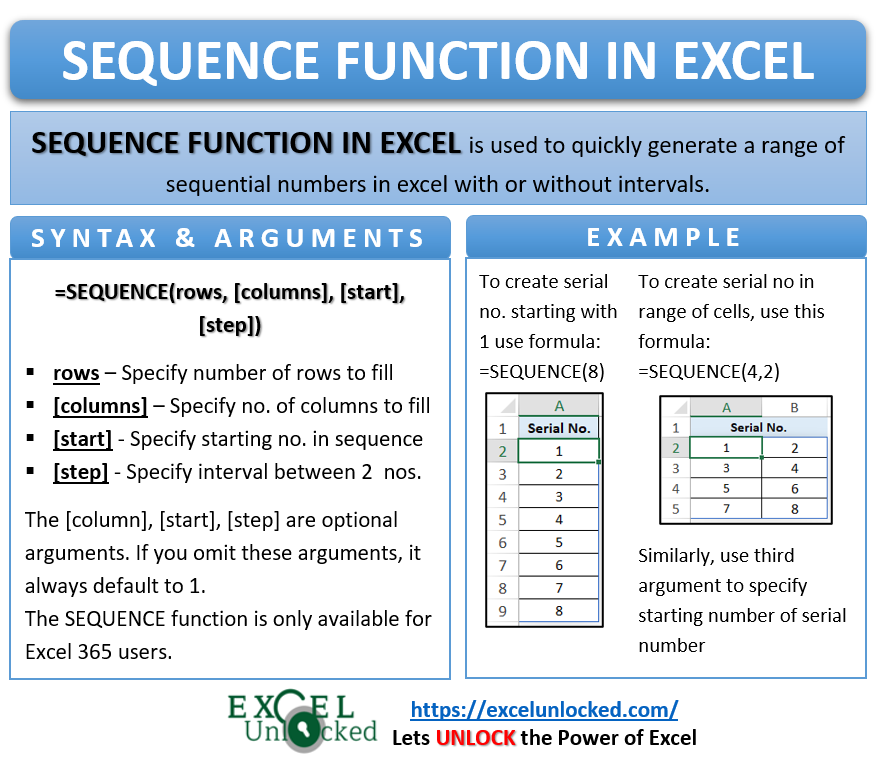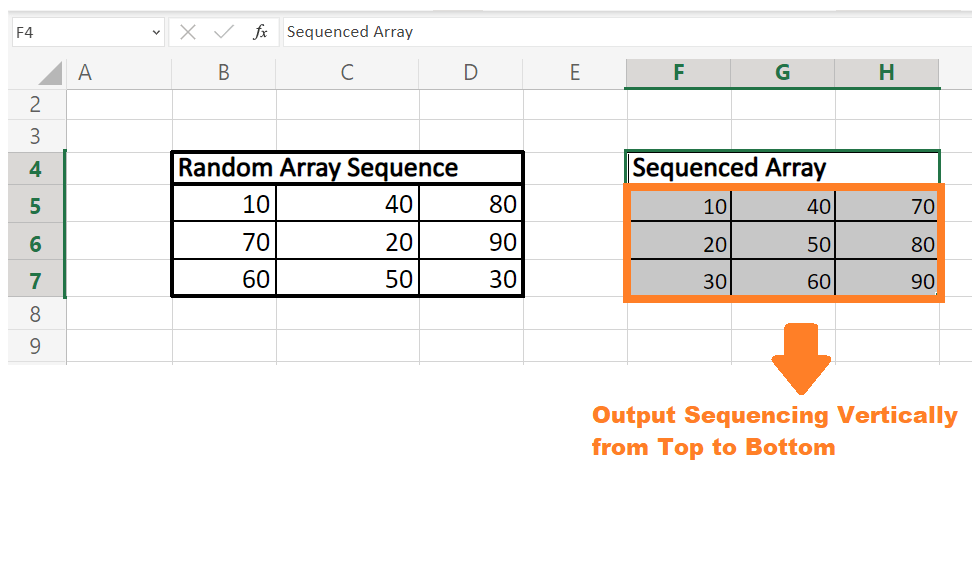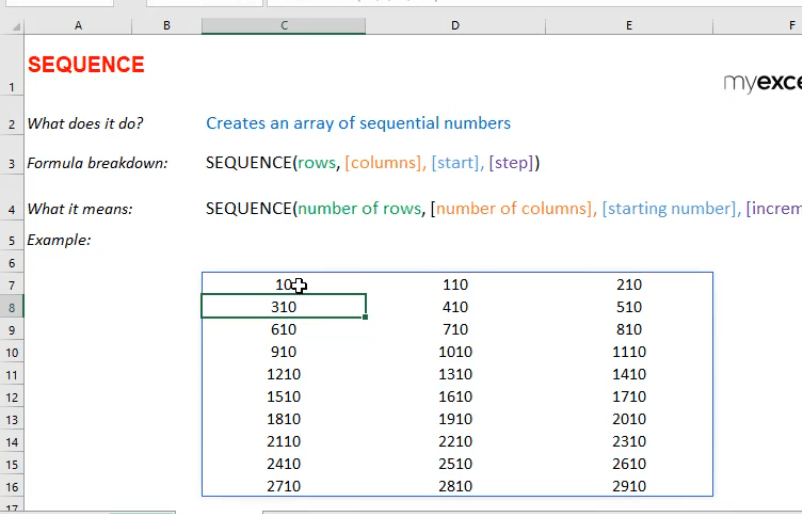
Excel SEQUENCE function Exceljet
This is a demo of Excel's new Sequence function that allows you to setup a sequence of numbers. It is one of the new DYNAMIC ARRAY functions in Excel as par.

Sequence Function in Excel Explanation with Bundle Examples YouTube
The SEQUENCE function creates a list of sequential numbers to a cell range or array. It is located in the Math and trigonometry category and is only availab. Only Excel 365 subscription version supports the new dynamic array formula like the SEQUENCE function, older Excel versions like Excel 2019, 2016, 2013, 2010, 2007 and earlier versions.

EXCEL function SEQUENCE for Excel 2007 to 2019
The Excel SEQUENCE function returns a list of sequential numbers in an array. Among other things, it will replace the need to use the ROW or COLUMN function to return an array of values for use in other functions. The syntax is: =SEQUENCE (rows, [columns], [start], [step]) rows Here you specify the number of rows to be returned. columns is.

sequence function in excel 2019 YouTube
5. Use of SEQUENCE Function to Generate Dates or Months in Excel i. Creating Sequential Dates with SEQUENCE and TODAY Functions. The SEQUENCE function is very useful for making a number of successive dates starting from a fixed date. By using the TODAY function inside as the third argument, we can define the current date which will be the start date. . Assuming we are going to create a list of.

How to Use SEQUENCE Function in Excel (16 Examples) ExcelDemy
The SEQUENCE function in Excel is used to generate an array of sequential numbers such as 1, 2, 3, etc. It is a new dynamic array function introduced in Microsoft Excel 365. The result is a dynamic array that spills into the specified number of rows and columns automatically. The function has the following syntax:

SEQUENCE Function in Excel Introduction + 2 Awesome Examples YouTube
The SEQUENCE function is one of the new dynamic array functions that Microsoft released as part of introducing the dynamic arrays. This function makes use of changes to Excel's calculation engine, which enables a single formula to display (or "spill" if using the new terminology) results in multiple cells.In the case of SEQUENCE, it will generate a list of sequential numbers in a two.

SEQUENCE Function in Excel Generate Number Series Excel Unlocked
In conclusion, the SEQUENCE function in Excel is a powerful tool that can help you generate sequences of numbers, dates, or text strings quickly and easily. With its flexible syntax and ability to generate arrays of any size and shape, SEQUENCE is a useful function for a variety of tasks, from simple number generation to complex data analysis.

Sequences and series in Excel YouTube
The SEQUENCE function lets you generate numeric sequences, which can be used for dates, times, and more. The SEQUENCE function takes four arguments. The first argument, rows controls how many rows SEQUENCE returns. This argument is required. The second argument, columns, controls the number of columns returned by SEQUENCE.

How to Use the Excel SEQUENCE Function YouTube
The SEQUENCE Function in Excel. To get a sequence of numbers we used to use a combination of functions but now MS has provided one function for getting sequential numbers. The SEQUENCE function of Excel returns a sequence of numeric values. You can also adjust the steps in the sequence along with the rows and columns.

SEQUENCE function Excel Practice Online
The SEQUENCE Function Explained. In its simplest form, the SEQUENCE function outputs a list of sequential numbers. We can specify how many rows and how many columns we need and also the step value. The SEQUENCE function is one of the new dynamic array functions in Excel and so has the ability to 'spill' results into multiple cells.

How to Generate Sequence Numbers in Excel (Using Vlookup) 5 YouTube
SEQUENCE and other Functions. To generate a sequence of Dates, we enter the following formula in A2: =SEQUENCE(5,1,C2,C5) C2 is the Start Date whose value has been set to 1/1/2020. C5 is the Number of Days the sequence increments by, it's been set to 1. We could use the DATE Function instead of referencing other cells.

Sequence Function in Excel javatpoint
Example. If you need to create a quick sample dataset, here's an example using SEQUENCE with TEXT, DATE, YEAR, and TODAY to create a dynamic list of months for a header row, where the underlying date will always be the current year. Our formula is: =TEXT(DATE(YEAR(TODAY()),SEQUENCE(1,6),1),"mmm"). Here's an example of nesting SEQUENCE with INT and RAND to create a 5 row by 6 column array with.

SEQUENCE Formula in Excel
In this tutorial, we will teach you how to use the Excel SEQUENCE function. First, we will show you what not to do when creating a sequential number column i.

Excel SEQUENCE FUNCTION YouTube
The SEQUENCE function takes four arguments: rows, columns, start, and step. All values default to 1. The rows and columns arguments control the number of rows and columns that should be generated in the output. For example, the formulas below generate numbers between 1 and 5 in rows and columns: Note the output from SEQUENCE is an array of.

How to Use SEQUENCE Function in Excel (16 Examples) ExcelDemy
Add an Excel SEQUENCE function to cell B8 to populate the calendar with date serial numbers that relate to the chosen Year and Month. Click in cell B8. Click: Formulas->Function Library->Math & Trig->Sequence. The Excel sequence function's Function Arguments dialog appears: Clearly you need to populate five rows and seven columns with dates.

How to Use SEQUENCE Function in Excel (16 Examples) ExcelDemy
The SEQUENCE Function = SEQUENCE (rows,[columns],[start],[step]) SEQUENCE is my favorite dynamic array function - I definitely use it the most. Here are few examples to create various sequences. The LET Function: While not specifically what this article about, you'll see that I'm using the LET function in the following examples. This isn't.